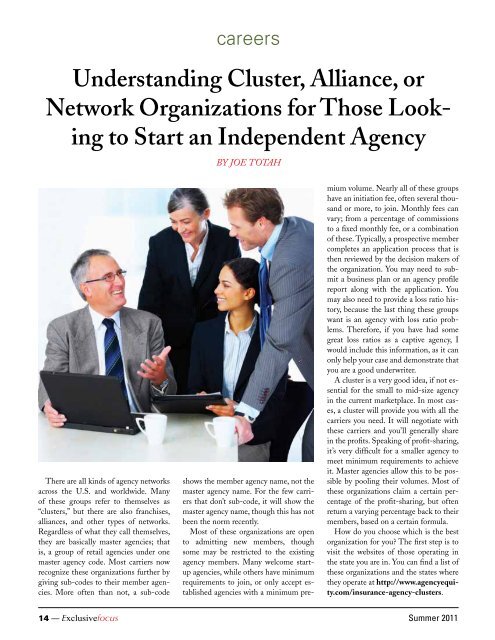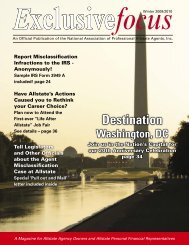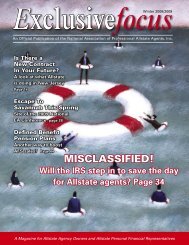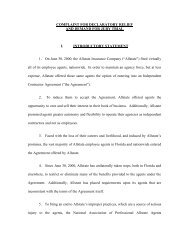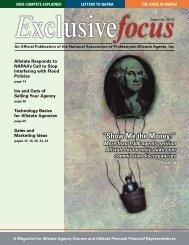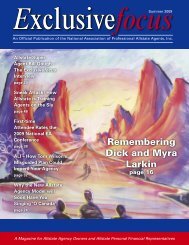NAPAA - National Association of Professional Allstate Agents, Inc.
NAPAA - National Association of Professional Allstate Agents, Inc.
NAPAA - National Association of Professional Allstate Agents, Inc.
You also want an ePaper? Increase the reach of your titles
YUMPU automatically turns print PDFs into web optimized ePapers that Google loves.
careers<br />
Understanding Cluster, Alliance, or<br />
Network Organizations for Those Looking<br />
to Start an Independent Agency<br />
By Joe Totah<br />
There are all kinds <strong>of</strong> agency networks<br />
across the U.S. and worldwide. Many<br />
<strong>of</strong> these groups refer to themselves as<br />
“clusters,” but there are also franchises,<br />
alliances, and other types <strong>of</strong> networks.<br />
Regardless <strong>of</strong> what they call themselves,<br />
they are basically master agencies; that<br />
is, a group <strong>of</strong> retail agencies under one<br />
master agency code. Most carriers now<br />
recognize these organizations further by<br />
giving sub-codes to their member agencies.<br />
More <strong>of</strong>ten than not, a sub-code<br />
shows the member agency name, not the<br />
master agency name. For the few carriers<br />
that don’t sub-code, it will show the<br />
master agency name, though this has not<br />
been the norm recently.<br />
Most <strong>of</strong> these organizations are open<br />
to admitting new members, though<br />
some may be restricted to the existing<br />
agency members. Many welcome startup<br />
agencies, while others have minimum<br />
requirements to join, or only accept established<br />
agencies with a minimum premium<br />
volume. Nearly all <strong>of</strong> these groups<br />
have an initiation fee, <strong>of</strong>ten several thousand<br />
or more, to join. Monthly fees can<br />
vary; from a percentage <strong>of</strong> commissions<br />
to a fixed monthly fee, or a combination<br />
<strong>of</strong> these. Typically, a prospective member<br />
completes an application process that is<br />
then reviewed by the decision makers <strong>of</strong><br />
the organization. You may need to submit<br />
a business plan or an agency pr<strong>of</strong>ile<br />
report along with the application. You<br />
may also need to provide a loss ratio history,<br />
because the last thing these groups<br />
want is an agency with loss ratio problems.<br />
Therefore, if you have had some<br />
great loss ratios as a captive agency, I<br />
would include this information, as it can<br />
only help your case and demonstrate that<br />
you are a good underwriter.<br />
A cluster is a very good idea, if not essential<br />
for the small to mid-size agency<br />
in the current marketplace. In most cases,<br />
a cluster will provide you with all the<br />
carriers you need. It will negotiate with<br />
these carriers and you’ll generally share<br />
in the pr<strong>of</strong>its. Speaking <strong>of</strong> pr<strong>of</strong>it-sharing,<br />
it’s very difficult for a smaller agency to<br />
meet minimum requirements to achieve<br />
it. Master agencies allow this to be possible<br />
by pooling their volumes. Most <strong>of</strong><br />
these organizations claim a certain percentage<br />
<strong>of</strong> the pr<strong>of</strong>it-sharing, but <strong>of</strong>ten<br />
return a varying percentage back to their<br />
members, based on a certain formula.<br />
How do you choose which is the best<br />
organization for you The first step is to<br />
visit the websites <strong>of</strong> those operating in<br />
the state you are in. You can find a list <strong>of</strong><br />
these organizations and the states where<br />
they operate at http://www.agencyequity.com/insurance-agency-clusters.<br />
14 — Exclusivefocus Summer 2011


